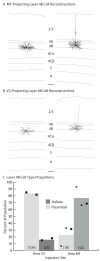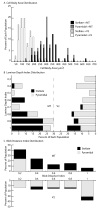Specialized circuits from primary visual cortex to V2 and area MT
- PMID: 17785186
- PMCID: PMC2727861
- DOI: 10.1016/j.neuron.2007.07.037
Specialized circuits from primary visual cortex to V2 and area MT
Abstract
Primary visual cortex recombines inputs from magnocellular (M) and parvocellular (P) streams to create functionally specialized outputs. Understanding these input-output relationships is complicated by the fact that layer 4B, which provides outputs to dorsal visual areas, contains multiple cell types. Using a modified rabies virus that expresses green fluorescent protein, we show that layer 4B neurons projecting to MT are a majority spiny stellate, whereas those projecting to V2 are overwhelmingly pyramidal. Regardless of cell type, MT-projecting neurons have larger cell bodies, more dendritic length, and are deeper within layer 4B. Furthermore, MT-projecting pyramidal neurons are located preferentially underneath cytochrome oxidase blobs, indicating that MT-projecting neurons of both types restrict their dendrites to M-recipient zones. We conclude that MT-projecting layer 4B neurons are specialized for the fast transmission of information from the M pathway, while V2-projecting neurons are likely to mediate slower computations involving mixed M and P signals.
Figures





References
-
- Barone P, Dehay C, Berland M, Bullier J, Kennedy H. Developmental remodeling of primate visual cortical pathways. Cereb Cortex. 1995;5:22–38. - PubMed
-
- Boyd JD, Casagrande VA. Relationships between cytochrome oxidase (CO) blobs in primate primary visual cortex (V1) and the distribution of neurons projecting to the middle temporal area (MT) J Comp Neurol. 1999;409:573–591. - PubMed
-
- Burkhalter A, Felleman DJ, Newsome WT, Van Essen DC. Anatomical and physiological asymmetries related to visual areas V3 and VP in macaque extrastriate cortex. Vision Res. 1986;26:63–80. - PubMed
-
- Callaway EM. Local circuits in primary visual cortex of the macaque monkey. Annu Rev Neurosci. 1998a;21:47–74. - PubMed
Publication types
MeSH terms
Substances
Grants and funding
LinkOut - more resources
Full Text Sources

